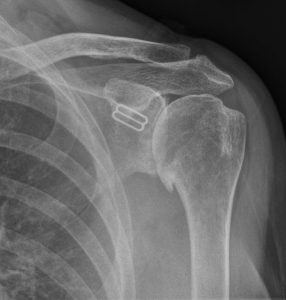Shoulder Arthritis (Glenohumeral Arthritis)
Arthritis of the main joint in the shoulder
What is it?
Arthritis is the loss of the cartilage lining the joint surface (articular cartilage). Normally this is a soft glistening smooth white tissue which acts as a bearing surface to allow the joint to move freely. If the cartilage is damaged the surface becomes rough and no longer glides. This causes pain and stiffness within the joint.
The most commonly affected joints are the hip and the knee. The shoulder is rarely affected.

Xray of a shoulder showing arthritis
What Causes it?
- Osteoarthritis: Less common in the shoulder than in the hip and knee. It may be genetic (inherited) or may be due to heavy manual work but a specific cause is usually not found.
- Rheumatoid arthritis: This condition affects joints and organs throughout the body.
- Trauma: If the shoulder joint has been broken (fractured) at some point the cartilage may have been damaged
- Instability: If the shoulder has dislocated a number of times the cartilage may have been damaged with each dislocation
What are the symptoms?
Pain is usually the first complaint. It is often felt deep in the shoulder and may be difficult to locate precisely. The shoulder may feel stiff and weak. There may be a sensation of grinding or catching within the shoulder. On occasion there may be crunching which can be heard.
How is the diagnosis made?
The doctor will listen to the description of the symptoms and will examine the shoulder. Plain Xrays are usually sufficient to make the diagnosis. If there is a concern that there may be more than arthritis in the shoulder (e.g. a rotator cuff tear) further investigations will be preformed.
What is the initial treatment?
There is no cure for arthritis. If the cause is rheumatoid arthritis a rheumatologist will be involved to optimize the medications to control the condition. If one of the other causes is responsible initial treatment consists of painkillers and anti-inflammatories, exercises to strengthen the rotator cuff and lifestyle modification (avoiding the things that hurt)
If initial treatment doesn’t work, what’s next?
Corticosteroid injection into the shoulder can give pain relief. The amount of benefit is variable as is the duration which may be as little as days or as long as months.
Arthroscopy and debridement in which the arthroscope is introduced into the shoulder and the rough cartilage is smoothed down also has variable results with benefits as variable as those seen with injection although usually longer lasting.
Shoulder replacements in which the arthritic shoulder joint is replaced with a new one of metal and plastic give relief of pain in 90% of patients. The replacements last on average 15 years.